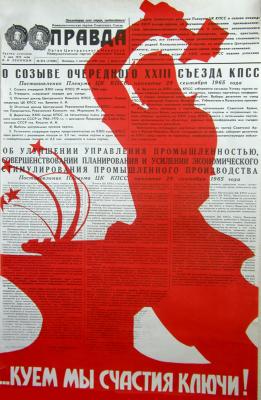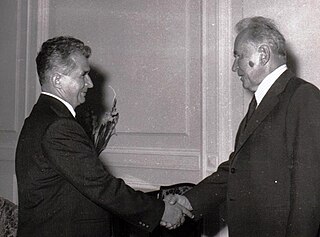Related Research Articles

Leonid Ilyich Brezhnev was a Soviet politician who served as General Secretary of the Communist Party of the Soviet Union from 1964 until his death in 1982, and Chairman of the Presidium of the Supreme Soviet from 1960 to 1964 and again from 1977 to 1982. His 18-year term as General Secretary was second only to Joseph Stalin's in duration. To this day, the value of Brezhnev's tenure as General Secretary remains debated by historians. While his rule was characterized by political stability and significant foreign policy achievements, it was also marked by corruption, inefficiency, economic stagnation, and rapidly growing technological gaps with the West.

Andrei Pavlovich Kirilenko was a Soviet statesman from the start to the end of the Cold War. In 1906, Kirilenko was born at Alexeyevka in Belgorod Oblast to a Ukrainian working-class family. He graduated in the 1920s from a local vocational school, and again in the mid-to-late 1930s from the Rybinsk Aviation Technology Institute. He became a member of the All-Union Communist Party (Bolsheviks) in 1930. As many like him, Kirilenko climbed up the Soviet hierarchy through the "industrial ladder"; by the 1960s, he was vice-chairman of the Bureau of the Central Committee of the Russian Soviet Federative Socialist Republic (RSFSR). After Nikita Khrushchev's forced resignation, Kirilenko became Leonid Brezhnev's "chief lieutenant" within the Central Committee.
Nikolai Viktorovich Podgorny was a Soviet statesman who served as the Chairman of the Presidium of the Supreme Soviet, the head of state of the Soviet Union, from 1965 to 1977.

Alexei Nikolayevich Kosygin was a Soviet statesman during the Cold War. He served as the Premier of the Soviet Union from 1964 to 1980 and was one of the most influential Soviet policymakers in the mid-1960s along with General Secretary Leonid Brezhnev.

An index of articles related to the former nation known as the Soviet Union. It covers the Soviet revolutionary period until the dissolution of the Soviet Union. This list includes topics, events, persons and other items of national significance within the Soviet Union. It does not include places within the Soviet Union, unless the place is associated with an event of national significance. This index also does not contain items related to Soviet Military History.

Nikolai Aleksandrovich Tikhonov was a Soviet Russian-Ukrainian statesman during the Cold War. He served as Chairman of the Council of Ministers from 1980 to 1985, and as a First Deputy Chairman of the Council of Ministers, literally First Vice Premier, from 1976 to 1980. Tikhonov was responsible for the cultural and economic administration of the Soviet Union during the late era of stagnation. He was replaced as Chairman of the Council of Ministers in 1985 by Nikolai Ryzhkov. In the same year, he lost his seat in the Politburo; however, he retained his seat in the Central Committee until 1989.

Nikolai Ivanovich Ryzhkov is a former Soviet, and later Russian, politician. He served as the last Chairman of the Council of Ministers. Responsible for the cultural and economic administration of the Soviet Union during the Gorbachev era, Ryzhkov was succeeded as premier by Valentin Pavlov in 1991. The same year, he lost his seat on the Presidential Council, going on to become Boris Yeltsin's leading opponent in the Russian Soviet Federative Socialist Republic (RSFSR) 1991 presidential election. He is also the last surviving Premier of the Soviet Union, following the death of Ivan Silayev on 8 February 2023.

The "Era of Stagnation" is a term coined by Mikhail Gorbachev in order to describe the negative way in which he viewed the economic, political, and social policies of the Soviet Union that began during the rule of Leonid Brezhnev (1964–1982) and continued under Yuri Andropov (1982–1984) and Konstantin Chernenko (1984–1985). It is sometimes called the "Brezhnevian Stagnation" in English.

The 1965 Soviet economic reform, sometimes called the Kosygin reform or Liberman reform, was a set of planned changes in the economy of the USSR. A centerpiece of these changes was the introduction of profitability and sales as the two key indicators of enterprise success. Some of an enterprise's profits would go to three funds, used to reward workers and expand operations; most would go to the central budget.

The 1979 Soviet economic reform, or "Improving planning and reinforcing the effects of the economic mechanism on raising the effectiveness in production and improving the quality of work", was an economic reform initiated by Alexei Kosygin, the Chairman of the Council of Ministers. During Leonid Brezhnev's rule of the Union of Soviet Socialist Republics (USSR) the Soviet economy began to stagnate; this period is referred to by historians as the Era of Stagnation. Even after several reform attempts by Kosygin and his protégés, the economic situation in the country continued to deteriorate. In contrast to his earlier reform initiative, the 26th Congress decided that his government would implement the reform during the Eleventh five-year plan from 1981–1985. This never happened, and even Brezhnev complained that implementation of the reform had been slow. This unfinished reform is seen by some as the last major pre-perestroika reform initiative put forward by the Soviet government.
The Eleventh Five-Year Plan, or the 11th Five-Year Plan, of the Union of Soviet Socialist Republics (USSR) was a set of goals designed to strengthen the country's economy between 1981 and 1985. The plan was presented by the Chairman of the Council of Ministers Nikolai Tikhonov at the 26th Congress of the Communist Party of the Soviet Union (CPSU).
The Ninth Five-Year Plan of the Union of Soviet Socialist Republics (USSR) was a set of economic goals designed to strengthen the country's economy between 1971 and 1975. There was a marked slowdown in nearly all sectors of the Soviet economy by the time it ended. The plan was presented by the Chairman of the Council of Ministers Alexei Kosygin at the 24th Congress of the Communist Party of the Soviet Union (CPSU) in 1971.

The 1973 Soviet economic reform was an economic reform initiated by Alexei Kosygin, the Chairman of the Council of Ministers. During Leonid Brezhnev's rule of the Union of Soviet Socialist Republics (USSR), the Soviet economy began to stagnate; this period is referred to by some historians as the Era of Stagnation. After the failed 1965 reform Kosygin initiated another reform in 1973 to enhance the powers and functions of the regional planners by establishing associations. The reform was never fully implemented, and members of the Soviet leadership complained that the reform had not even been fully implemented by the time of the 1979 reform.

The history of the Soviet Union from 1964 to 1982, referred to as the Brezhnev Era, covers the period of Leonid Brezhnev's rule of the Union of Soviet Socialist Republics (USSR). This period began with high economic growth and soaring prosperity, but gradually significant problems in social, political, and economic areas accumulated, so that the period is often described as the Era of Stagnation. In the 1970s, both sides took a stance of "detente". The goal of this strategy was to warm up relations, in the hope that the Soviet Union would pursue economic and democratic reforms. However, this did not come until Mikhail Gorbachev took office in 1985.

The history of Soviet Russia and the Soviet Union (USSR) reflects a period of change for both Russia and the world. Though the terms "Soviet Russia" and "Soviet Union" often are synonymous in everyday speech, when referring to the foundations of the Soviet Union, "Soviet Russia" often specifically refers to brief period between the October Revolution of 1917 and the creation of the Soviet Union in 1922.

Collective leadership, or collectivity of leadership, was considered the ideal form of governance in the Union of Soviet Socialist Republics (USSR) and other socialist states espousing communism. Its main task was to distribute powers and functions among the Politburo and the Central Committee of the Communist Party of the Soviet Union, as well as the Council of Ministers, to hinder any attempts to create a one-man dominance over the Soviet political system by a Soviet leader, such as that seen under Joseph Stalin's rule. On the national level, the heart of the collective leadership was officially the Central Committee of the Communist Party. Collective leadership was characterised by limiting the powers of the General Secretary and the Chairman of the Council of Ministers as related to other offices by enhancing the powers of collective bodies, such as the Politburo.

The Council of Ministers of the Union of Soviet Socialist Republics, was the de jure government of the Union of Soviet Socialist Republics (USSR), comprising the main executive and administrative agency of the USSR from 1946 until 1991.

The Premier of the Soviet Union was the head of government of the Union of Soviet Socialist Republics (USSR). Twelve individuals held the post. Among the most known are Vladimir Lenin and Joseph Stalin.

The economy of the Soviet Union was based on state ownership of the means of production, collective farming, and industrial manufacturing. An administrative-command system managed a distinctive form of central planning. The Soviet economy was characterized by state control of investment, prices, a dependence on natural resources, lack of consumer goods, little foreign trade, public ownership of industrial assets, macroeconomic stability, low unemployment and high job security.
The Eighth Five-Year Plan of the Union of Soviet Socialist Republics (USSR) was a set of production goals and guidelines for administering the economy from 1966 to 1970—part of a series of such plans used by the USSR from 1928 until its dissolution. "Directives" for the plan involved set high goals for industrial production, especially in vehicles and appliances. These directives for the Eighth Five-Year Plan was approved by the Central Committee of the Communist Party of the Soviet Union and by the 23rd Congress of the Communist Party of the Soviet Union but no final version was apparently ever ratified by the Supreme Soviet of the Soviet Union. Nevertheless, some of the changes envisioned were made.
References
- Notes
- ↑ D. Barry, Donald (1979). Soviet law after Stalin: Soviet institutions and the administration of law. Brill Publishers. p. 123. ISBN 90-286-0679-3.
- 1 2 Crawford, Beverly (1993). Economic vulnerability in international relations: the case of East-West trade, investment, and finance . Columbia University Press. p. 91. ISBN 0-231-08297-5.
- ↑ Hanson, Philip (2003). The rise and fall of the Soviet economy: an economic history of the USSR from 1945. Pearson Education. p. 149. ISBN 0-582-29958-6.
- ↑ Chakravarti; R.N.; Basu, A.K. (1987). Soviet Union: Land and People. Northern Book Centre. p. 63. ISBN 81-85119-29-5.
- ↑ Johnston, Michael; Heidenheimer, Arnold J. (1989). Political corruption: a handbook. Transaction Publishers. p. 457. ISBN 0-88738-163-4.
- ↑ Theodore Shabad and Victor L. Mote: Gateway to Siberian Resources (The BAM) p. 73 (Halstead Press/John Wiley, New York, 1977) ISBN 0-470-99040-6
- ↑ Hardt, John Pearce; McMillan, Charles H. (1988). Planned economies: confronting the challenges of the 1980s. M.E. Sharpe. p. 88. ISBN 0-87332-470-6.
- ↑ Hanson, Philip (2003). The rise and fall of the Soviet economy: an economic history of the USSR from 1945. Pearson Education. p. 132. ISBN 0-582-29958-6.
- ↑ Dellenbrant, Jan Åke (1986). The Soviet regional dilemma: planning, people, and natural resources . M.E. Sharpe. p. 111. ISBN 0-87332-384-X.
- ↑ Dellenbrant, Jan Åke (1986). The Soviet regional dilemma: planning, people, and natural resources . M.E. Sharpe. p. 142. ISBN 0-87332-384-X.
- ↑ Dellenbrant, Jan Åke (1986). The Soviet regional dilemma: planning, people, and natural resources . M.E. Sharpe. p. 137. ISBN 0-87332-384-X.
- ↑ Dellenbrant, Jan Åke (1986). The Soviet regional dilemma: planning, people, and natural resources . M.E. Sharpe. p. 108. ISBN 0-87332-384-X.
- ↑ ютуба, любитель (17 December 2010). "30 лет назад умер Алексей Косыгин" [A reformer before Yegor Gaidar? Kosygin died for 30 years ago]. Newsland (in Russian). Retrieved 3 January 2011.